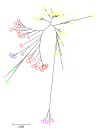Multilocus sequence types of Finnish bovine Campylobacter jejuni isolates and their attribution to human infections
- PMID: 20659332
- PMCID: PMC2914712
- DOI: 10.1186/1471-2180-10-200
Multilocus sequence types of Finnish bovine Campylobacter jejuni isolates and their attribution to human infections
Abstract
Background: Campylobacter jejuni is the most common bacterial cause of human gastroenteritis worldwide. Due to the sporadic nature of infection, sources often remain unknown. Multilocus sequence typing (MLST) has been successfully applied to population genetics of Campylobacter jejuni and mathematical modelling can be applied to the sequence data. Here, we analysed the population structure of a total of 250 Finnish C. jejuni isolates from bovines, poultry meat and humans collected in 2003 using a combination of Bayesian clustering (BAPS software) and phylogenetic analysis.
Results: In the first phase we analysed sequence types (STs) of 102 Finnish bovine C. jejuni isolates by MLST and found a high diversity totalling 50 STs of which nearly half were novel. In the second phase we included MLST data from domestic human isolates as well as poultry C. jejuni isolates from the same time period. Between the human and bovine isolates we found an overlap of 72.2%, while 69% of the human isolates were overlapping with the chicken isolates. In the BAPS analysis 44.3% of the human isolates were found in bovine-associated BAPS clusters and 45.4% of the human isolates were found in the poultry-associated BAPS cluster. BAPS reflected the phylogeny of our data very well.
Conclusions: These findings suggest that bovines and poultry were equally important as reservoirs for human C. jejuni infections in Finland in 2003. Our results differ from those obtained in other countries where poultry has been identified as the most important source for human infections. The low prevalence of C. jejuni in poultry flocks in Finland could explain the lower attribution of human infection to poultry. Of the human isolates 10.3% were found in clusters not associated with any host which warrants further investigation, with particular focus on waterborne transmission routes and companion animals.
Figures
Similar articles
-
Population Genetics and Characterization of Campylobacter jejuni Isolates from Western Jackdaws and Game Birds in Finland.Appl Environ Microbiol. 2019 Feb 6;85(4):e02365-18. doi: 10.1128/AEM.02365-18. Print 2019 Feb 15. Appl Environ Microbiol. 2019. PMID: 30552190 Free PMC article.
-
MLST-based genetic relatedness of Campylobacter jejuni isolated from chickens and humans in Poland.PLoS One. 2020 Jan 24;15(1):e0226238. doi: 10.1371/journal.pone.0226238. eCollection 2020. PLoS One. 2020. PMID: 31978059 Free PMC article.
-
Multilocus sequence typing, pulsed-field gel electrophoresis, and fla short variable region typing of clonal complexes of Campylobacter jejuni strains of human, bovine, and poultry origins in Luxembourg.Appl Environ Microbiol. 2008 Dec;74(24):7715-22. doi: 10.1128/AEM.00865-08. Epub 2008 Oct 17. Appl Environ Microbiol. 2008. PMID: 18931296 Free PMC article.
-
A systematic review of source attribution of human campylobacteriosis using multilocus sequence typing.Euro Surveill. 2019 Oct;24(43):1800696. doi: 10.2807/1560-7917.ES.2019.24.43.1800696. Euro Surveill. 2019. PMID: 31662159 Free PMC article.
-
Campylobacter sequence typing databases: applications and future prospects.Microbiology (Reading). 2012 Nov;158(Pt 11):2695-2709. doi: 10.1099/mic.0.062000-0. Epub 2012 Sep 17. Microbiology (Reading). 2012. PMID: 22986295 Review.
Cited by
-
Practicalities of using non-local or non-recent multilocus sequence typing data for source attribution in space and time of human campylobacteriosis.PLoS One. 2013;8(2):e55029. doi: 10.1371/journal.pone.0055029. Epub 2013 Feb 6. PLoS One. 2013. PMID: 23405107 Free PMC article.
-
Closely related Campylobacter jejuni strains from different sources reveal a generalist rather than a specialist lifestyle.BMC Genomics. 2011 Nov 28;12:584. doi: 10.1186/1471-2164-12-584. BMC Genomics. 2011. PMID: 22122991 Free PMC article.
-
Human Campylobacteriosis Cases Traceable to Chicken Meat-Evidence for Disseminated Outbreaks in Finland.Pathogens. 2020 Oct 22;9(11):868. doi: 10.3390/pathogens9110868. Pathogens. 2020. PMID: 33105906 Free PMC article.
-
Zoonotic Transmission of Campylobacter jejuni to Caretakers From Sick Pen Calves Carrying a Mixed Population of Strains With and Without Guillain Barré Syndrome-Associated Lipooligosaccharide Loci.Front Microbiol. 2022 Apr 29;13:800269. doi: 10.3389/fmicb.2022.800269. eCollection 2022. Front Microbiol. 2022. PMID: 35591997 Free PMC article.
-
Antimicrobial resistance and antimicrobial use associated with laboratory-confirmed cases of Campylobacter infection in two health units in Ontario.Can J Infect Dis Med Microbiol. 2013 Spring;24(1):e16-21. doi: 10.1155/2013/176494. Can J Infect Dis Med Microbiol. 2013. PMID: 24421795 Free PMC article.
References
-
- Olson KE, Ethelberg S, van Pelt W, Tauxe RV. In: Campylobacter. Third. Nachamkin I, Szymanski CM, Blaser MJ, editor. ASM Press Washington, DC USA; 2008. Epidemiology of Campylobacter jejuni Infections in Industrialized Nations; pp. 163–189.
-
- European Food Safety Authority. The community summary report on trends and sources of zoonoses zoonotic agents antimicrobial resistance and foodborne outbreaks in the Europian Union 2006. 2007. http://www.efsa.europa.eu/en/scdocs/doc/130r.pdf
-
- Terveyden Hyvinvoinnin Laitos Tilastotietokanta. http://www3.ktl.fi/stat/
-
- Kapperud G, Espeland G, Wahl E, Walde A, Herikstad H, Gustavsen S, Tveit I, Natas O, Bevanger L, Digranes A. Factors associated with increased and decreased risk of Campylobacter infection: a prospective case-control study in Norway. Am J Epidemiol. 2003;158:234–242. doi: 10.1093/aje/kwg139. - DOI - PubMed
Publication types
MeSH terms
Grants and funding
LinkOut - more resources
Full Text Sources
Medical


